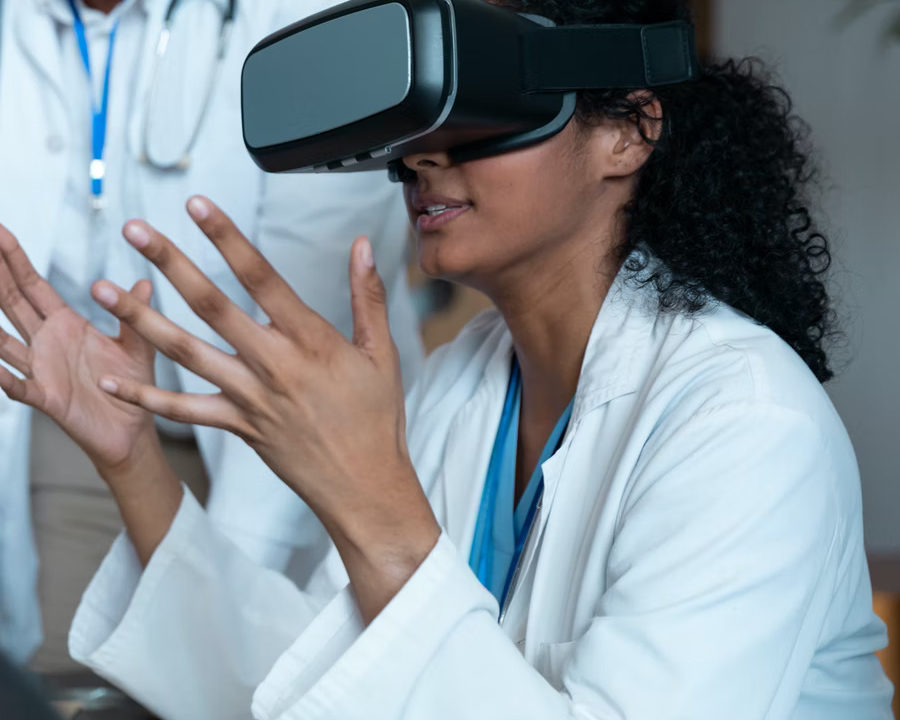
How Virtual Reality is Transforming Healthcare
Although often associated with gaming, virtual reality (VR) is a next-generation technology whose applications can revolutionize a host of industries. In healthcare, practitioners are exploring exciting ways that VR can assist patients and health providers to achieve better treatments and outcomes, including in surgery, pain management, physical and cognitive rehabilitation, mental health, and more.
Improving Surgical Efficiency
George Washington University is using an advanced VR tool for neurosurgery and thoracic surgery, enabling surgeons to virtually explore a patient’s brain and body prior to performing a procedure. The result is improved surgical efficiency and situation awareness. Patients and their families are also able to gain a better understanding of procedures ahead of time. A Harvard Business Review study found that VR training improved participants’ overall surgical performance by 230% compared with traditional methods.
UConn Health is also leveraging VR solutions from PrecisionOS and Oculus to provide training to its orthopedic surgery residents. Not only does this create invaluable practice opportunities for surgeons, it also saves time and money, as traditional practice with cadavers only allows residents to complete certain procedures once.
Increasing Empathy
Some hospitals are also using VR simulations to help doctors better understand what their patients are going through. VR can simulate health conditions for ailments such as dementia, Parkinson’s disease, or a migraine headache. In training for aging services, for example, studies showed that VR enhanced students’ understanding of age-related health problems and increased their empathy for older adults with vision and hearing loss or Alzheimer’s disease.
Diminishing Pain
VR has proven to be an effective tool for treating and diminishing pain. Cedars-Sinai Hospital has found that a VR experience can reduce pain by 24% or more. VR applications can also be used to help women in labor, patients suffering from acute and chronic pain, and more. Often, virtual reality treatment can reduce or remove the need for pharmaceutical therapies.
VR headsets are also being used to help sick and injured children deal with treatments by providing an escape into digital worlds and games. By distracting them from their pain and anxiety, VR actually reduces the amount of pain and anxiety that is experienced by patients. A study from the University of Washington found that burn patients reported experiencing significantly less pain when distracted with VR, and fMRI brain scans of pain-related brain activity were significantly reduced while engaging with the technology.
Enhancing Physical Therapy Treatments
For patients in need of physical rehabilitation, VR has been shown to be an effective tool in treatments. Through programs like motion-enabled games, VR can reproduce precise physical movements and provide additional motivation for exercises. Therapists could adjust all settings to adapt programs to their patients. Moreover, VR rehab can also allow patients to virtually practice real-life skills, such as grocery shopping or dishwashing.
In children with cerebral palsy, VR has also been found to be a useful treatment method that can significantly improve motor functions.
Improving Memory and Cognitive Functions
Some startups, including MyndVR and Rendever, are using VR technology to help seniors improve their memory and cognitive function, rehab therapy, and socialization. Studies have shown that VR intervention can improve cognitive and motor function in older adults with mild cognitive impairment or dementia, especially in attention and execution, member, global cognition, and balance.
In cognitive rehabilitation efforts, including for diseases like multiple sclerosis (MS) and spatial deficits after stroke, studies have found that VR could strengthen the effects of traditional therapies by increasing sensory input and promoting multisensory integration and processing.
Treating Mental Health
Patients can use VR to address anxiety and trauma. For example, a psychologist can treat a patient traumatized by a car crash through virtual exposure therapy to public streets, a safer environment for a patient than an in-person visit. Its effectiveness is often dramatic; A study found that VR exposure therapy reduced fear of heights by a self-reported 68% on average. The same kind of treatment can also be used to help patients suffering from other psychological ailments and phobias, including depression, post-traumatic stress disorder, and more.
Transforming Industries
The medical applications of virtual reality are myriad, and researchers continue to discover new ways to leverage the technology to augment healthcare and deliver more effective treatments for patients. VR is rapidly advancing, with a compounding annual growth rate of 30.3%. It stands at the precipice of penetrating and transforming many industries, and we all stand to benefit.
The Weekly Download
Subscribe to receive a weekly roundup of the Chamber Technology Engagement Center (C_TEC) and relevant U.S. Chamber advocacy and events.
The Weekly Download will keep you updated on emerging tech issues including privacy, telecommunications, artificial intelligence, transportation, and government digital transformation.
